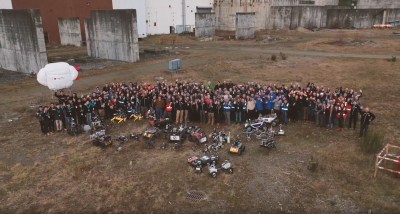Robots might be finding their footing above ground, but today’s autonomous robots have a difficult time operating underground. DARPA wanted to give the state of the art a push forward, so they are running a Subterranean (SubT) Challenge which just wrapped up its latest round. A great review of this Urban Circuit competition (and some of the teams participating in it) has been published by IEEE Spectrum. This is the second of three underground problem subdomains presented to the participants, six months apart, preparing them for the final event which will combine all three types.
If you missed the livestream or prefer edited highlight videos, they’re all part of DARPAtv’s Subterranean Challenge playlist. Today it starts with a compilation of Urban Circuit highlights and continues to other videos. Including team profiles, video walkthrough of competition courses, actual competition footage, edited recap videos, and the awards ceremony. Half of the playlist are video from the Tunnels Circuit six months ago, so we can compare to see how teams performed and what they’ve learned along the way. Many more lessons were learned in the just-completed Urban Circuit and teams will spend the next six months improving their robots. By then we’ll have the Caves Circuit competition with teams ready to learn new lessons about operating robots underground.
 The systems track (actual robots in real world environments) competition took place at an unfinished nuclear power plant in Elma, Washington. Its less-than-pristine concrete and metal environment represented complex urban underground infrastructure. If the facility looks familiar, that may be because it is also occasionally rented by the entertainment industry for filming. This SubT competition was likely the innocent reason why DARPA sent out some ominous-sounding tweets several few months ago. As outlined in that request, the two competition courses challenged robots with navigating irregular shaped areas spanning from claustrophobic tight quarters to spaces the size of auditoriums, spread across multiple floors.
The systems track (actual robots in real world environments) competition took place at an unfinished nuclear power plant in Elma, Washington. Its less-than-pristine concrete and metal environment represented complex urban underground infrastructure. If the facility looks familiar, that may be because it is also occasionally rented by the entertainment industry for filming. This SubT competition was likely the innocent reason why DARPA sent out some ominous-sounding tweets several few months ago. As outlined in that request, the two competition courses challenged robots with navigating irregular shaped areas spanning from claustrophobic tight quarters to spaces the size of auditoriums, spread across multiple floors.
All of this is only dimly lit (if at all) so robots using cameras needed to bring their own bright lights. To solve the challenge of widely varying terrain, many teams sent in groups of different robots and each were deployed for their specialties. For these robots to coordinate, they also had to bring their own networking infrastructure. We see several robots setting down mesh network nodes that can also function as location beacons, just like Hansel and Gretel’s bread crumbs.
Read the IEEE Spectrum story for more stories of last-minute hacks. See the team that chopped chunks out of their robot wheels to help it climb stairs, the team that rushed out and bought a laptop computer to replace a fried robot brain, and the team that put a member on a trans-Pacific flight as overnight courier for critical replacement parts.
For those that rather watch videos, here is DARPAtv’s playlist for Subterranean Challenge.
















Needs subterranean GPS. Neutrino detector for “sun is that way”.
You’d have trouble getting a decent neutrino detector on a semi-trailer, given they need a large mass, usually water or oil for the neutrinos to interact with.
since this takes place in the US, sourcing an “ICBM-grade” IMU should only be a question of $1-2k…it’s a box just about the size of a human palm and the gyro drift is low enough that for a couple of hours it’d be plenty accurate for subterran navigation.
However, there’s still this:
https://youtu.be/D3yYjaLmiqU
you get a polygon model with textures, no worthless point clouds. Very useful in case something caves in or shifts in a undesired manner, can be analyzed on the go by experts far away while the bot keeps on chugging.
wait, what, i heard ‘warfighters’?